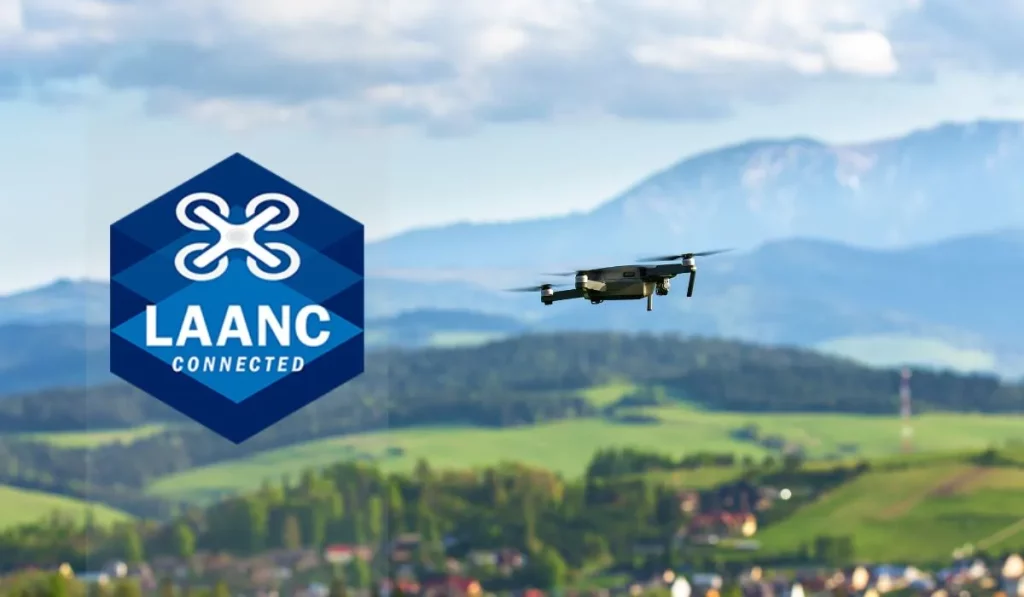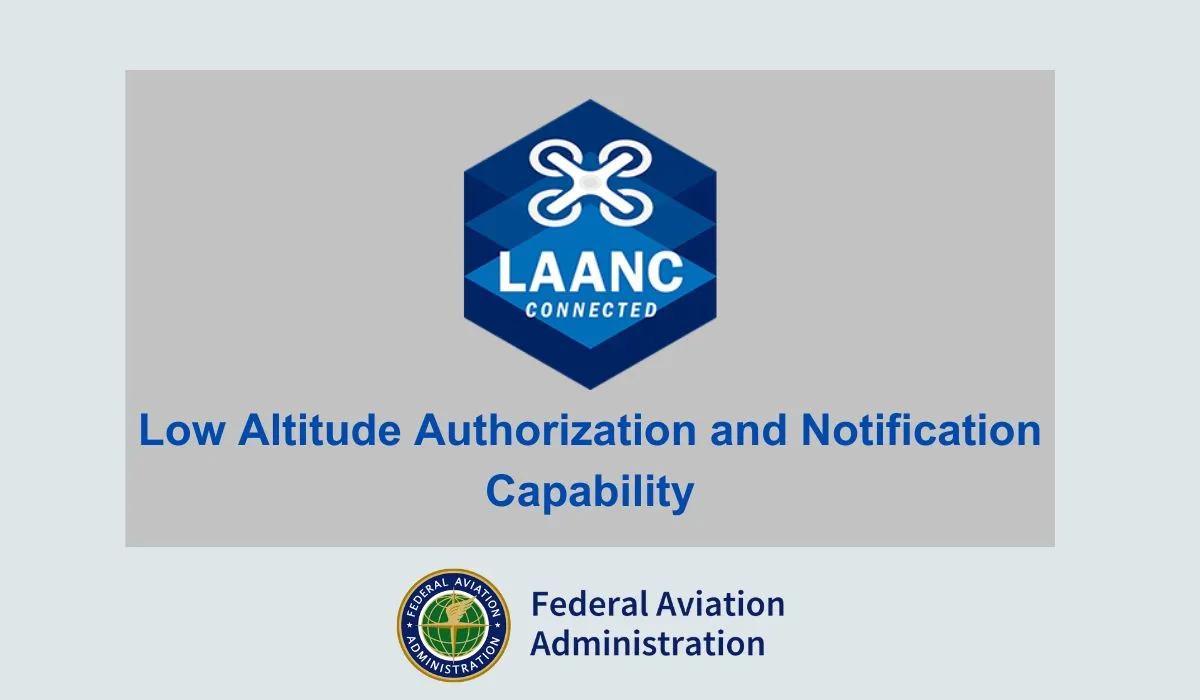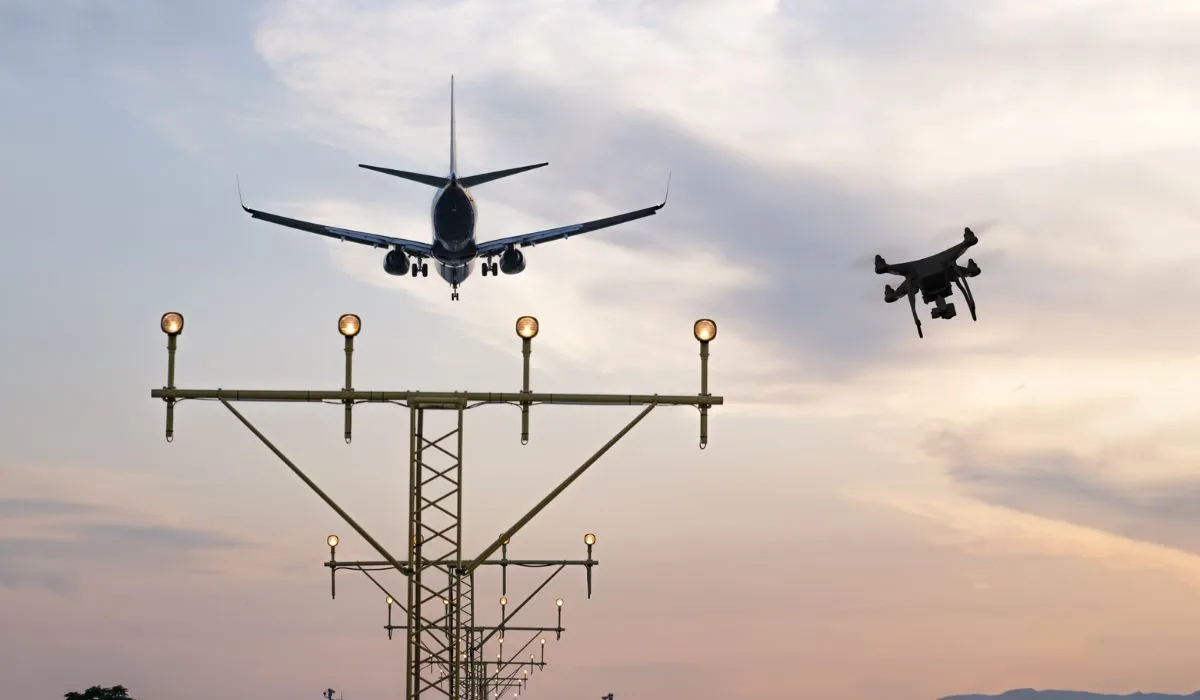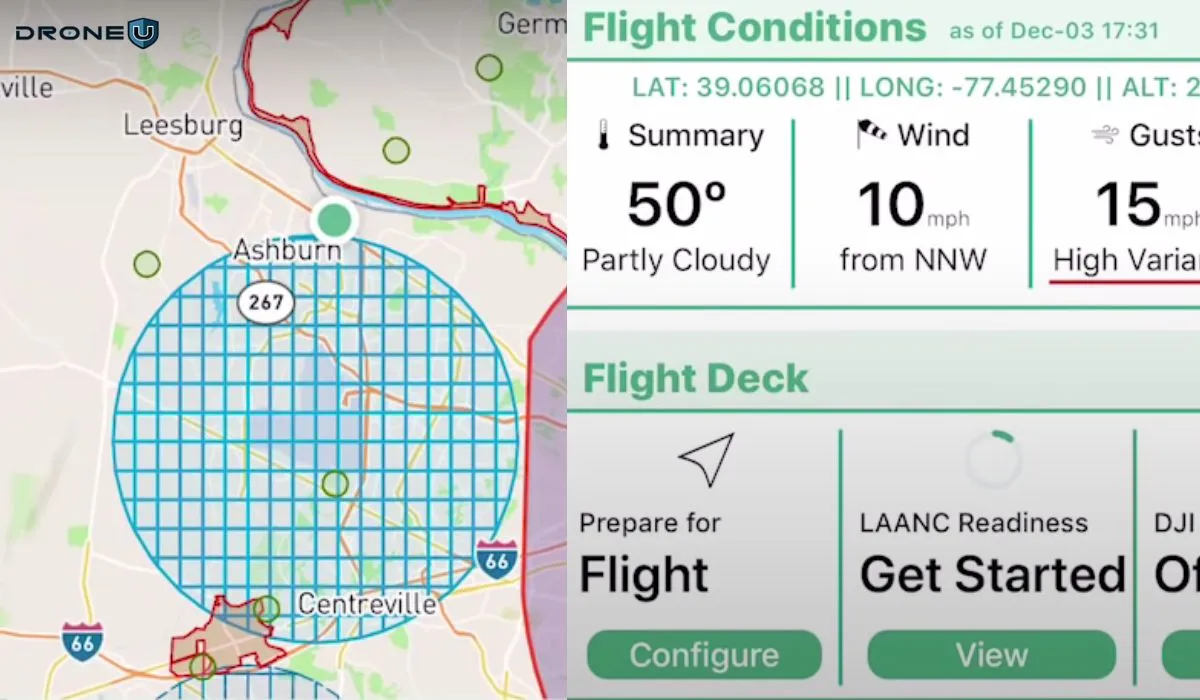
The US drone industry is booming, but navigating airspace regulations can feel like flying through a maze. This is where the LAANC Authorization comes in – a revolutionary tool that simplifies airspace access for drone pilots.
With LAANC authorization, you can fly legally within controlled airspace, eliminating the time-consuming manual authorization process and allowing you to focus on what matters most: safe and efficient drone operations.
In this comprehensive guide, we’ll discuss LAANC, its importance, operational procedures, the application process, and essential guidelines for drone pilots.
What Is LAANC Authorization?

LAANC, standing for Low Altitude Authorization and Notification Capability, is a joint venture between the Federal Aviation Administration (FAA) and private industry. Its primary role is to facilitate the integration of Unmanned Aircraft Systems (UAS) into the national airspace.
LAANC offers three key benefits for drone pilots:
- Expanded Flight Opportunities: LAANC unlocks controlled airspace, allowing flights up to 400 feet near airports that were previously off-limits to drones.
- Enhanced Flight Planning: The system provides clear maps and information on where drone flight is allowed and restricted.
- Improved Airspace Safety: Air traffic controllers can see where and when drones are operating, promoting better coordination and safety in the shared airspace.
LAANC operates through the UAS Data Exchange, a system that enables the exchange of airspace data between the FAA and FAA-approved companies, known as UAS Service Suppliers (USS). These suppliers offer the necessary desktop applications and mobile apps that enable the use of LAANC services. LAANC offers a streamlined process for obtaining airspace authorizations, especially near airports.
How Does LAANC Authorization Work?
LAANC streamlines the process of obtaining airspace authorizations by automating applications and approvals. You can submit the requests through systems provided by FAA-approved UAS Service Suppliers (USS).
These requests are then cross-referenced with various sources within the FAA UAS Data Exchange, including UAS Facility Maps, Special Use Airspace data, details on Airports and Airspace Classes, as well as Temporary Flight Restrictions (TFRs) and Notices to Air Missions (NOTAMs). Approvals are granted almost instantly.
When a drone pilot submits an authorization request, the LAANC system cross-references various FAA databases, including UAS Facility Maps, Special Use Airspace data, airport and airspace class details, Temporary Flight Restrictions (TFRs), and Notices to Air Missions (NOTAMs). Approvals are often granted almost instantly.
It’s important to note that LAANC only handles airspace authorizations. Pilots are still responsible for checking NOTAMs, assessing weather conditions, and complying with all other airspace restrictions.
The LAANC Authorization Application Process
 New Applicant Onboarding Process Timeline* | Source: FAA
New Applicant Onboarding Process Timeline* | Source: FAA
*A slight adjustment may be made due to calendar shifts from year to year. The exact dates will be published on the LAANC website.
The New Applicant Onboarding Process for LAANC is a five-step process:
- Application Period: Applicants familiarize themselves with key documents and submit a comprehensive application package.
- FAA Submission Review: The FAA evaluates applications and may request additional information.
- Technical Interviews: Successful applicants participate in mandatory technical interviews.
- Formal Testing: Selected applicants undergo integration testing with the LAANC Automation Platform.
- LAANC Go-Live: Approved USSs receive production LAANC credentials and connect to the LAANC system.
This comprehensive process ensures that all approved LAANC USSs meet the necessary standards and requirements for safe and effective operation within the LAANC framework.
The Benefits of LAANC Authorization
 Source: EASA
Source: EASA
For the Drone Industry:
- Collaboration with the FAA: LAANC paves the way for the drone industry to work with the FAA on developing a safe and efficient drone traffic management system (UTM). This system will be crucial for integrating drones seamlessly into the national airspace.
- Approved Service Providers: Companies approved to offer LAANC services become FAA Approved UAS Service Suppliers (USS). This signifies their expertise and role in streamlining drone operations.
For Drone Pilots:
- More Places to Fly: LAANC unlocks controlled airspace near airports, typically restricted areas for drones. This expands the possibilities for aerial photography, inspections, and other drone applications.
- Faster Flight Planning: The LAANC system offers quick, near-instantaneous authorization for airspace use, streamlining pre-flight planning and allowing pilots to react to opportunities more efficiently.
- Safety and Compliance: Using LAANC ensures pilots are following FAA regulations, promoting safety for both drones and manned aircraft in shared airspace.
- Efficiency and Flexibility: LAANC allows for more effective planning, especially in busy or sensitive areas. Pilots can make informed decisions about flight paths and avoid potential airspace conflicts.
- New Business Opportunities: For commercial pilots, LAANC opens doors to new possibilities in aerial photography, inspections, and other drone services. Recreational flyers also benefit from a wider range of legal flying locations.
- Improved Communication with Air Traffic Control: LAANC facilitates better communication with air traffic control, enhancing situational awareness and reducing the risk of airspace conflicts.
- Less Paperwork, More Flying: The automated LAANC system cuts down on administrative tasks, allowing pilots to spend more time on flight operations and less time on paperwork.
- Advanced Planning Options: Pilots can schedule flights up to 90 days in advance, making it easier to manage complex projects or multiple drone activities.
- Transparency and Tracking: LAANC provides a clear system for recording and monitoring drone flights. This transparency is crucial for regulatory compliance and helps pilots analyze their operations for improvement.
How and When Can Drone Pilots Use LAANC?
 LAANC Authorization Request
LAANC Authorization Request
Drone operators intending to fly at altitudes below 400 feet in controlled airspace near airports must obtain an airspace authorization from the FAA beforehand.
LAANC is accessible to those flying under the Small UAS Rule Part 107 or as Recreational Flyers, via FAA Approved LAANC UAS Service Suppliers.
LAANC usage involves two main approaches:
- Requesting near real-time authorization for flights under 400 feet in controlled airspace near airports, open to both Part 107 Pilots and Recreational Flyers.
- Submitting a “further coordination request” for flying above the altitude limit set in a UAS Facility Map, but still within 400 feet, a feature available only to Part 107 pilots who can apply up to 90 days before their flight.
Part 107 pilots must register their drone and possess a Remote Pilot Certificate.
Recreational Flyers are required to register their drone and complete the Recreational UAS Safety Test (TRUST) before their initial flight.
For operations in controlled airspace necessitating both a waiver and airspace authorization, applications for both must be submitted through the FAA’s DroneZone.
Approved LAANC UAS Service Suppliers
 Source: FAA
Source: FAA
The listed companies have fulfilled the necessary technical requirements and have formalized agreements with the FAA to offer LAANC Services:
| Approved Service Supplier | Part 107 Near — Real Time Authorization | Part 107 Further Coordination | Exception for Recreational Flying/Section 44809 | IOS App | Android App | Desktop |
| AirMatrix | Y | Y | Y | – | – | Y |
| Airspace Link | Y | Y | Y | Y | Y | Y |
| Aloft | Y | Y | Y | Y | Y | Y |
| AstraUTM | Y | Y | Y | Y | Y | – |
| AutoPylot | Y | – | Y | Y | Y | – |
| Avision | Y | Y | Y | Y | Y | Y |
| eTT Aviation | Y | Y | Y | – | – | Y |
| FlightReady | Y | Y | Y | Y | – | – |
| UASidekick | Y | Y | Y | Y | Y | Y |
| Wing | Y | – | Y | Y | Y | – |
*Y = publicly available service
LAANC Guidelines by FAA ATO
 UAS Facility Maps | Source: Aloft.AI
UAS Facility Maps | Source: Aloft.AI
Applicants to the LAANC USS should be aware of the following:
- The LAANC program, and its governing documents, are fluid and subject to change as rules and requirements continue to mature.
- This is not a Screening Information Request (SIR) or Request for Proposal (RFP). The FAA does not intend to release a SIR or RFP for LAANC Services.
- The FAA is not seeking or accepting unsolicited proposals outside of the New Applicant Onboarding Process.
- The FAA will not pay for any information received or costs incurred at any point in the New Applicant Onboarding Process.
- Any costs associated with the New Applicant Onboarding Process, providing LAANC services, or anything related to LAANC are incurred solely at the LAANC USS applicant’s expense.
- FAA New Applicant Onboarding Process decisions regarding any single LAANC USS applicant are in no way prejudiced by FAA decisions regarding other LAANC USS applicants.
- The FAA’s decision regarding the ability of a LAANC USS applicant to successfully complete the New Applicant Onboarding Process is final and at the FAA’s discretion. FAA decisions regarding the New Applicant Onboarding Process are not subject to protest.
- LAANC USS applicants who previously applied for and did not successfully complete the LAANC New Applicant Onboarding Process can apply during any future application period. The FAA does not attach any penalty to LAANC USS applicants who fail to successfully complete the New Applicant Onboarding Process.
- The New Applicant Onboarding Process, and all associated steps, apply in their entirety to all LAANC USS applicants. This includes previously approved LAANC USSs which are re-applying or previous applicants that began but did not complete the New Applicant Onboarding Process.
For more information, you can check out this document.
Frequently Asked Questions
1. How long does LAANC take to approve?
LAANC typically provides near real-time approvals for airspace authorizations. This means that once a request is submitted, the approval process is usually completed within a few minutes in most cases. Sometimes it may take more – anywhere between a few hours to a couple of days.
2. Who can use LAANC?
LAANC is available to both Part 107 certified pilots and recreational flyers.
3. How do I get a LAANC clearance?
To get LAANC clearance, pilots need to submit an airspace authorization request through a LAANC provider, using either a mobile app or desktop application provided by an FAA-approved UAS Service Supplier (USS).
4. Who is the best LAANC service provider?
LAANC authorization is revolutionizing drone operations by simplifying airspace access, enhancing safety, and opening up new opportunities for pilots and the industry. By understanding the LAANC process and guidelines, drone pilots can navigate FAA regulations confidently and safely.
For more information on LAANC authorization and FAA regulations, visit the official FAA website or consult with a trusted industry resource.







Add Your Comment